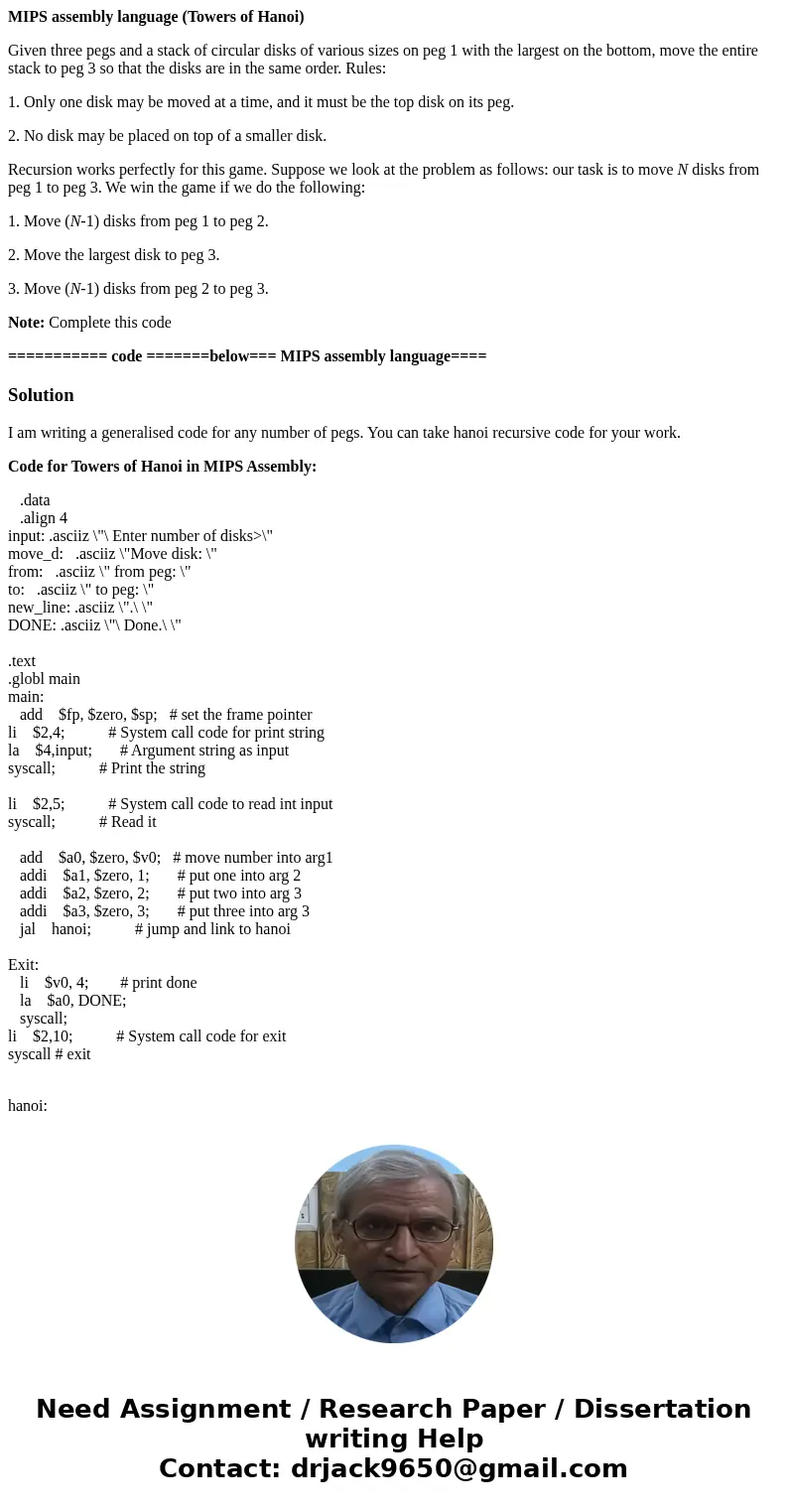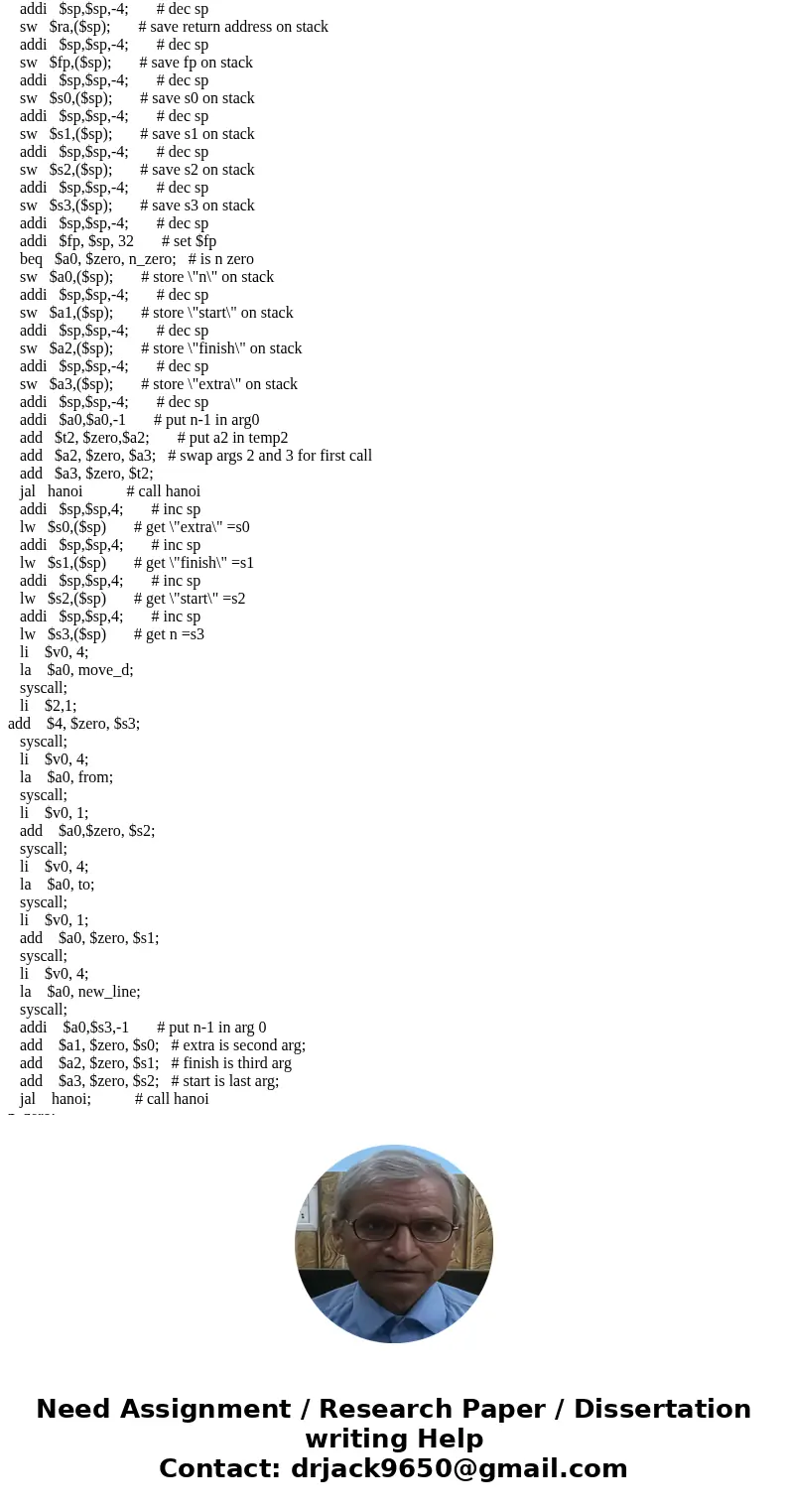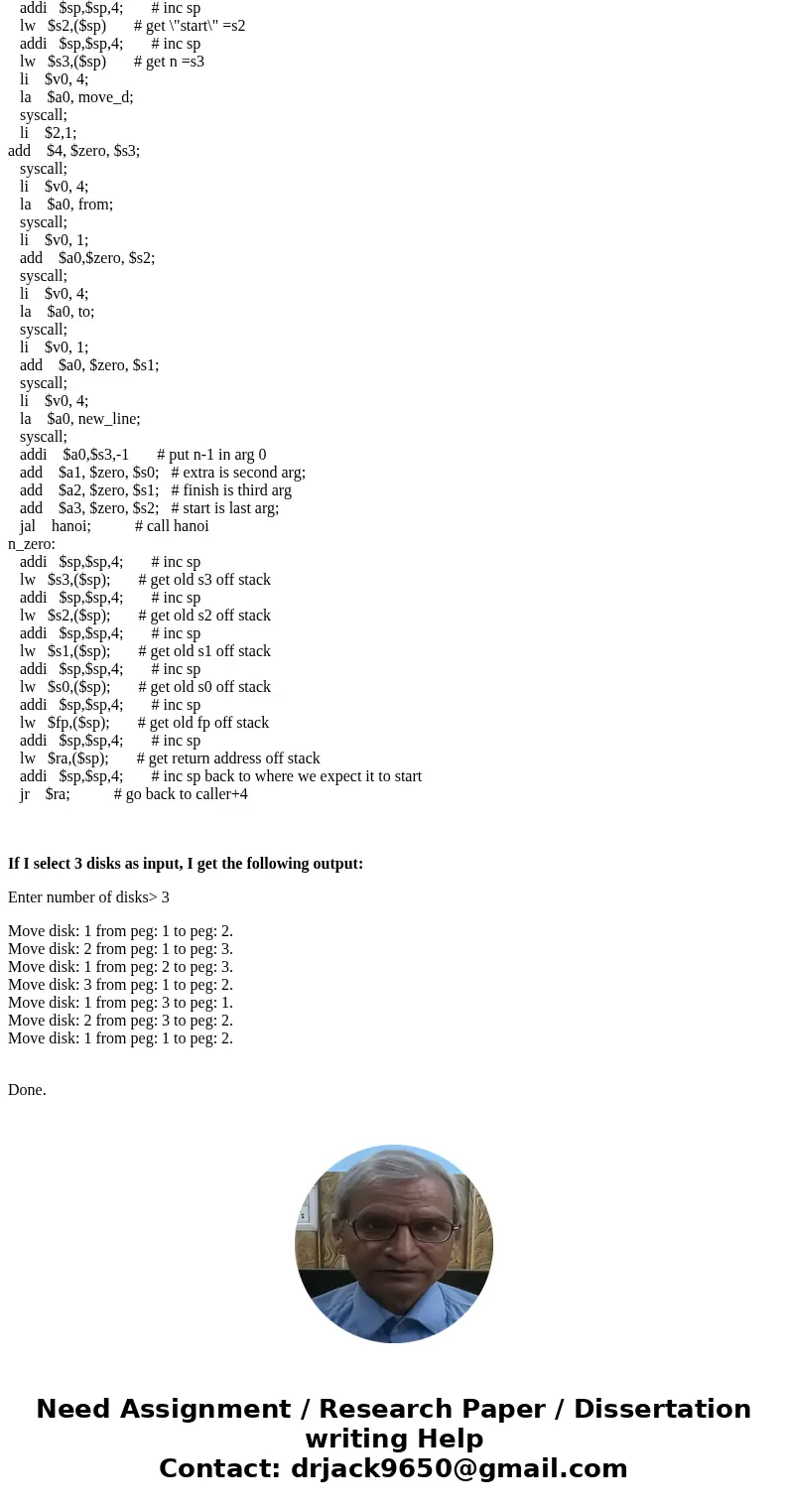MIPS assembly language Towers of Hanoi Given three pegs and
MIPS assembly language (Towers of Hanoi)
Given three pegs and a stack of circular disks of various sizes on peg 1 with the largest on the bottom, move the entire stack to peg 3 so that the disks are in the same order. Rules:
1. Only one disk may be moved at a time, and it must be the top disk on its peg.
2. No disk may be placed on top of a smaller disk.
Recursion works perfectly for this game. Suppose we look at the problem as follows: our task is to move N disks from peg 1 to peg 3. We win the game if we do the following:
1. Move (N-1) disks from peg 1 to peg 2.
2. Move the largest disk to peg 3.
3. Move (N-1) disks from peg 2 to peg 3.
Note: Complete this code
=========== code =======below=== MIPS assembly language====
Solution
I am writing a generalised code for any number of pegs. You can take hanoi recursive code for your work.
Code for Towers of Hanoi in MIPS Assembly:
.data
.align 4
input: .asciiz \"\ Enter number of disks>\"
move_d: .asciiz \"Move disk: \"
from: .asciiz \" from peg: \"
to: .asciiz \" to peg: \"
new_line: .asciiz \".\ \"
DONE: .asciiz \"\ Done.\ \"
.text
.globl main
main:
add $fp, $zero, $sp; # set the frame pointer
li $2,4; # System call code for print string
la $4,input; # Argument string as input
syscall; # Print the string
li $2,5; # System call code to read int input
syscall; # Read it
add $a0, $zero, $v0; # move number into arg1
addi $a1, $zero, 1; # put one into arg 2
addi $a2, $zero, 2; # put two into arg 3
addi $a3, $zero, 3; # put three into arg 3
jal hanoi; # jump and link to hanoi
Exit:
li $v0, 4; # print done
la $a0, DONE;
syscall;
li $2,10; # System call code for exit
syscall # exit
hanoi:
addi $sp,$sp,-4; # dec sp
sw $ra,($sp); # save return address on stack
addi $sp,$sp,-4; # dec sp
sw $fp,($sp); # save fp on stack
addi $sp,$sp,-4; # dec sp
sw $s0,($sp); # save s0 on stack
addi $sp,$sp,-4; # dec sp
sw $s1,($sp); # save s1 on stack
addi $sp,$sp,-4; # dec sp
sw $s2,($sp); # save s2 on stack
addi $sp,$sp,-4; # dec sp
sw $s3,($sp); # save s3 on stack
addi $sp,$sp,-4; # dec sp
addi $fp, $sp, 32 # set $fp
beq $a0, $zero, n_zero; # is n zero
sw $a0,($sp); # store \"n\" on stack
addi $sp,$sp,-4; # dec sp
sw $a1,($sp); # store \"start\" on stack
addi $sp,$sp,-4; # dec sp
sw $a2,($sp); # store \"finish\" on stack
addi $sp,$sp,-4; # dec sp
sw $a3,($sp); # store \"extra\" on stack
addi $sp,$sp,-4; # dec sp
addi $a0,$a0,-1 # put n-1 in arg0
add $t2, $zero,$a2; # put a2 in temp2
add $a2, $zero, $a3; # swap args 2 and 3 for first call
add $a3, $zero, $t2;
jal hanoi # call hanoi
addi $sp,$sp,4; # inc sp
lw $s0,($sp) # get \"extra\" =s0
addi $sp,$sp,4; # inc sp
lw $s1,($sp) # get \"finish\" =s1
addi $sp,$sp,4; # inc sp
lw $s2,($sp) # get \"start\" =s2
addi $sp,$sp,4; # inc sp
lw $s3,($sp) # get n =s3
li $v0, 4;
la $a0, move_d;
syscall;
li $2,1;
add $4, $zero, $s3;
syscall;
li $v0, 4;
la $a0, from;
syscall;
li $v0, 1;
add $a0,$zero, $s2;
syscall;
li $v0, 4;
la $a0, to;
syscall;
li $v0, 1;
add $a0, $zero, $s1;
syscall;
li $v0, 4;
la $a0, new_line;
syscall;
addi $a0,$s3,-1 # put n-1 in arg 0
add $a1, $zero, $s0; # extra is second arg;
add $a2, $zero, $s1; # finish is third arg
add $a3, $zero, $s2; # start is last arg;
jal hanoi; # call hanoi
n_zero:
addi $sp,$sp,4; # inc sp
lw $s3,($sp); # get old s3 off stack
addi $sp,$sp,4; # inc sp
lw $s2,($sp); # get old s2 off stack
addi $sp,$sp,4; # inc sp
lw $s1,($sp); # get old s1 off stack
addi $sp,$sp,4; # inc sp
lw $s0,($sp); # get old s0 off stack
addi $sp,$sp,4; # inc sp
lw $fp,($sp); # get old fp off stack
addi $sp,$sp,4; # inc sp
lw $ra,($sp); # get return address off stack
addi $sp,$sp,4; # inc sp back to where we expect it to start
jr $ra; # go back to caller+4
If I select 3 disks as input, I get the following output:
Enter number of disks> 3
Move disk: 1 from peg: 1 to peg: 2.
Move disk: 2 from peg: 1 to peg: 3.
Move disk: 1 from peg: 2 to peg: 3.
Move disk: 3 from peg: 1 to peg: 2.
Move disk: 1 from peg: 3 to peg: 1.
Move disk: 2 from peg: 3 to peg: 2.
Move disk: 1 from peg: 1 to peg: 2.
Done.



 Homework Sourse
Homework Sourse